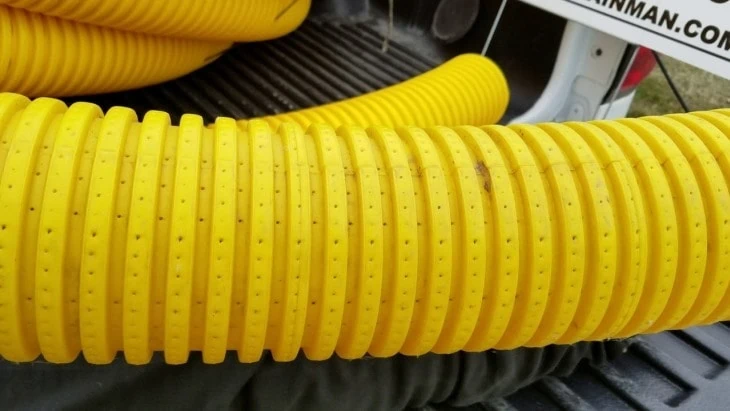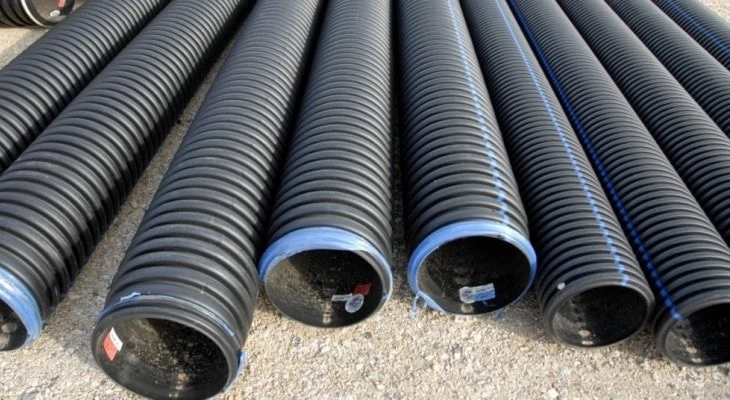If you are having problems with water drainage in or around your house, you may have encountered the fact that both solid and perforated drain pipes exist, and you may be wondering which one you need to purchase for your project.
Typically, perforated piping is used for drainage under the ground, while solid piping is used to carry water from the surface of the ground or to connect to subsurface piping to carry water away from the area. So, if you need to drain water away from below the ground, choose perforated piping, and if you need to drain water away from the surface of the ground, choose solid piping.
For some projects, both perforated and solid piping is required. This is typically the case if there are large areas where the water pools on the surface of the ground and seeps into the ground.
Table of Contents
When and How to Use Solid Piping

Solid piping is made for use at the surface level, meaning that it should not typically be installed underground. Solid piping is a great way to move large amounts of water away from a house or garage at the surface of the ground. Solid piping moves water very quickly, especially at larger diameters.
Installing solid piping is fairly easy. You simply dig a shallow trench wherever you intend to lay the pipe, and then sit the pipe in the trench and cover it back up with dirt and turf. If your problem is draining water away from a downspout, you’ll need to also install a drain pipe inlet that connects to the solid piping and collects the water from the downspout effectively.
You need to make sure that your pipe is sloped away from the area you’re draining. It should be about one-eighth of an inch per foot of pipe, sloped away from the house or wherever you are removing water from.
When and How to Use Perforated Piping

Perforated piping is made for use underground. The holes in the pipe allow water from the ground to seep into the pipe and run off into the drain of your choosing. Perforated piping is not effective at the surface level because the water will flow out of the holes in the pipe what there is too much water entering the pipe, making it essentially useless.
To use perforated piping, you’ll need to dig a trench. For this project, you’ll need to line the trench with two or three inches of gravel for drainage. Then, you’ll lay the piping down with the holes on the bottom side so that the water can fill the trench and seep into the pipe.
It’s important not to install the pipe with the holes on top, even if it seems counterintuitive. If the holes are on top, the water will not enter the pipe and it will not be an effective drainage system.
As with solid piping, you’ll want to lay the pipe on a slope of about one-eighth of an inch per foot of pipe so that the water will drain away from the area that you are trying to keep dry.
When to Use Both Solid Piping and Perforated Piping
If you have large areas where water pools on the surface of the ground, perforated subsurface piping will not cut it. You’ll need to also install surface solid piping to help with the runoff on the surface of the water because perforated piping does not move large amounts of water very quickly.
Pros and Cons of Solid and Perforated Piping

One pro of solid piping is that it collects water from a specific location and moves it away to a drain or runoff area. Possibly the biggest pro of solid piping is that it is easy to unclog with a drain snake, unlike perforated piping.
The major con of solid piping is that it is not particularly useful for underground applications because it does not collect water from the surrounding dirt, and only moves water through the dirt.
The biggest pro of perforated piping is that it both effectively collects water from the ground and can also move it away from an area. Perforated piping works well if a large area of land is too wet, as it collects water from the dirt itself rather than from one specific location.
One major con of perforated piping is that dirt can clog the holes in the pipe very easily, especially if there is a lot of water moving through the area. This means that the pipe will not pick up water as easily, and therefore, will move less water over time. You’ll need to replace perforated piping more often than solid piping because of this issue.
In Conclusion
It is fairly easy to determine whether you need to use perforated piping, solid piping, or a combination. Simply decide whether you are installing underground drainage or surface-level drainage. If you are needing underground drainage, choose perforated piping, and if you need surface-level drainage, use solid piping.


Thanks Brad, quickly, I was able to understand why use one over the other. It’s easy to think that in perforated pipe, water for example goes from inside to out in a diffused way vs. gathering water from the soil as it’s intended to do. Anyway, solid pipe for gutters/downspouts is what I’ll use and I appreciate the explanation.